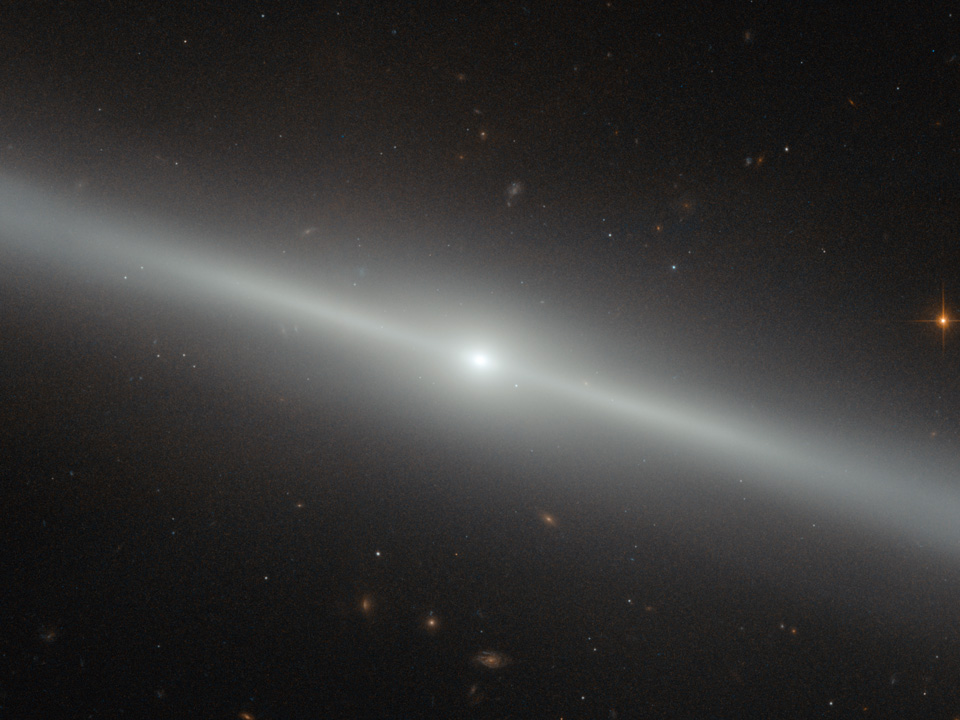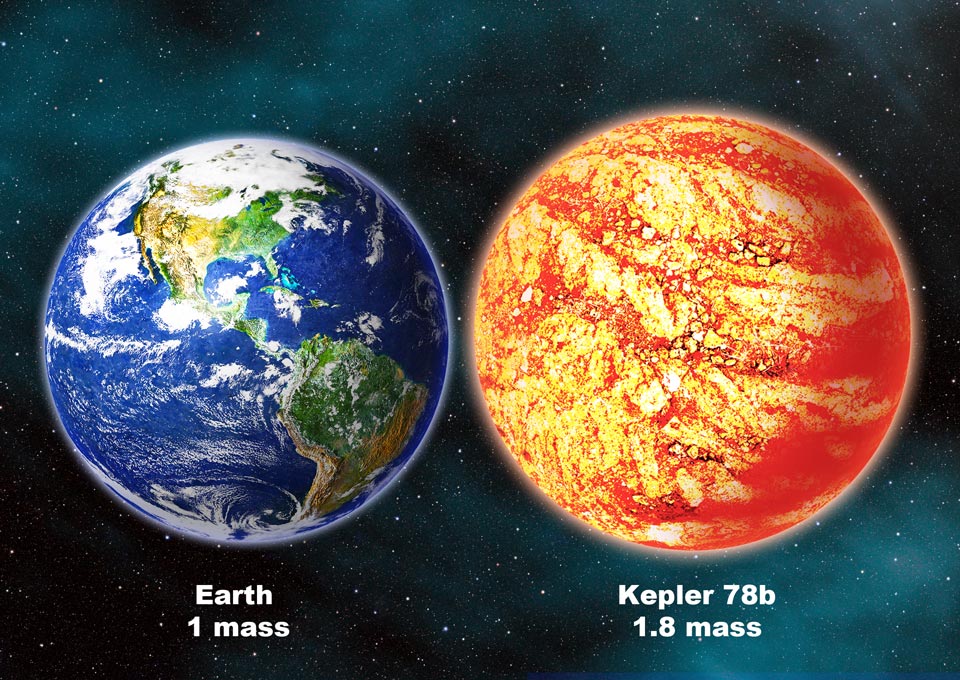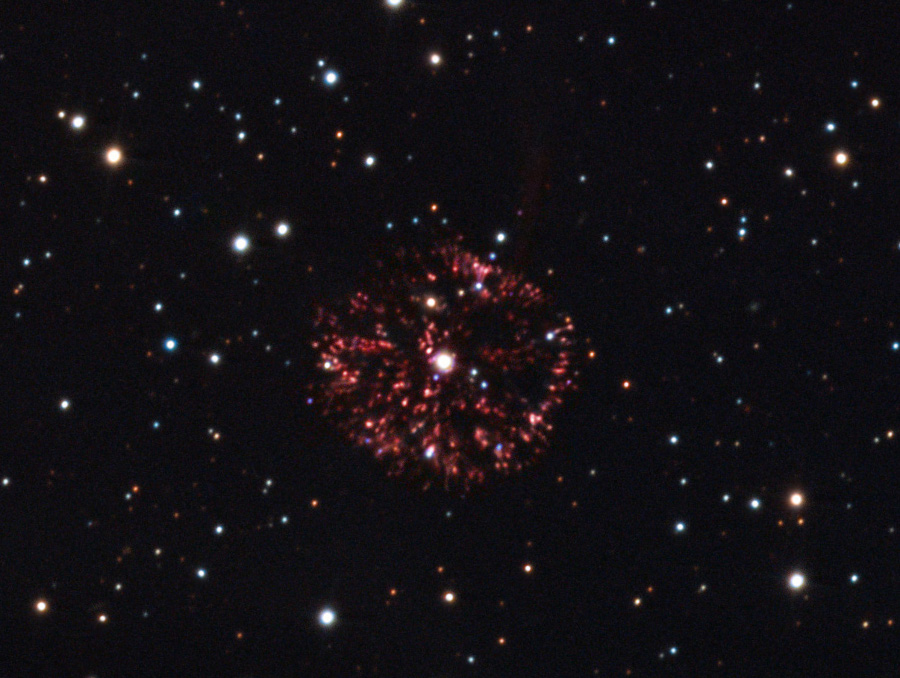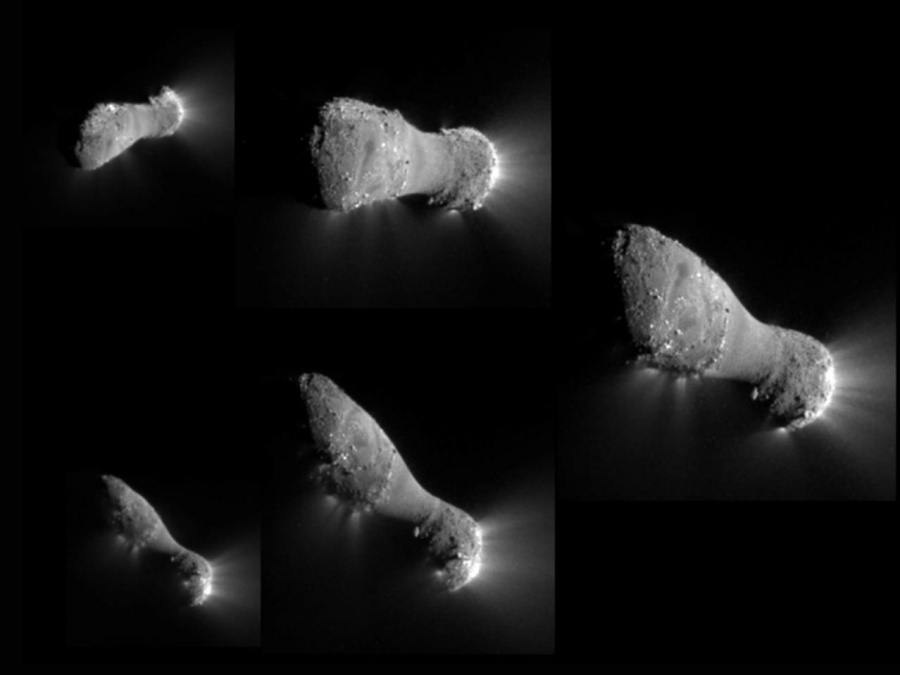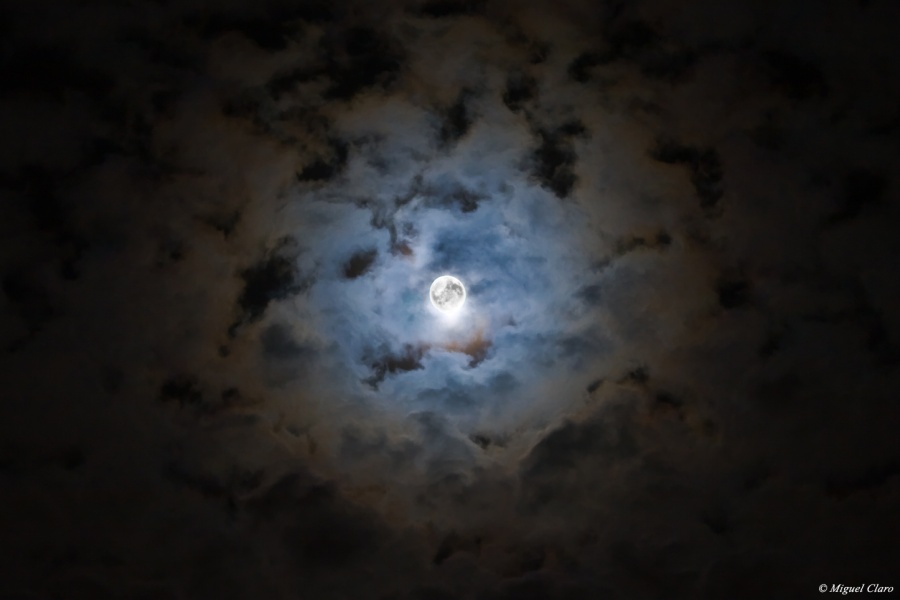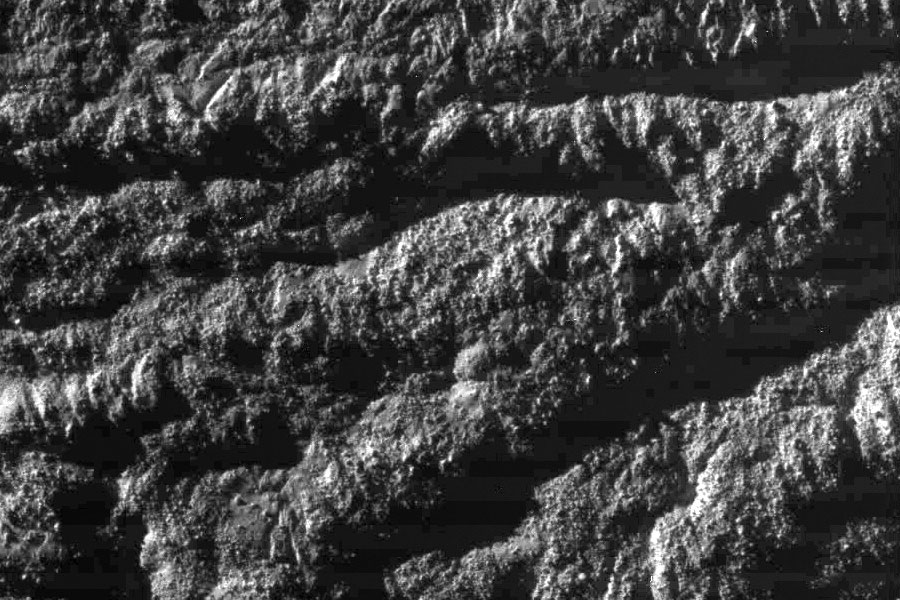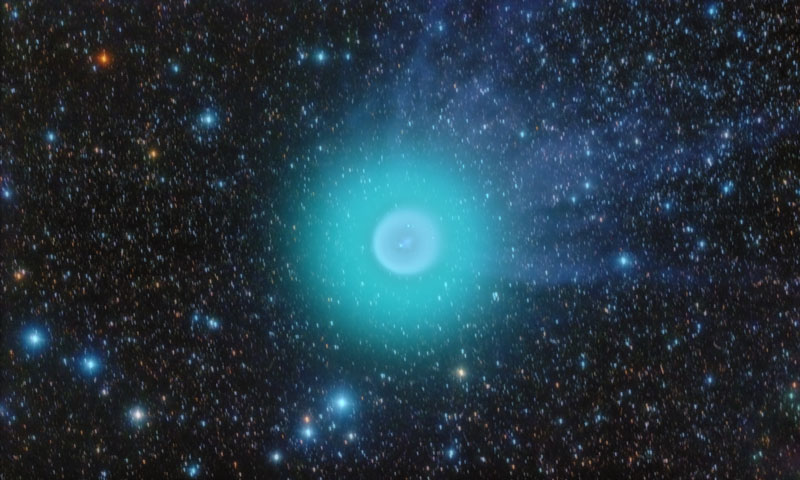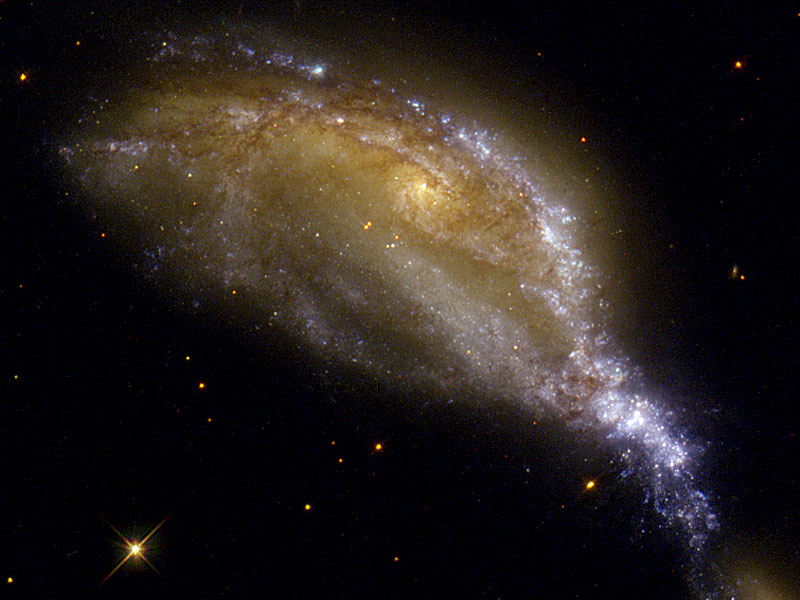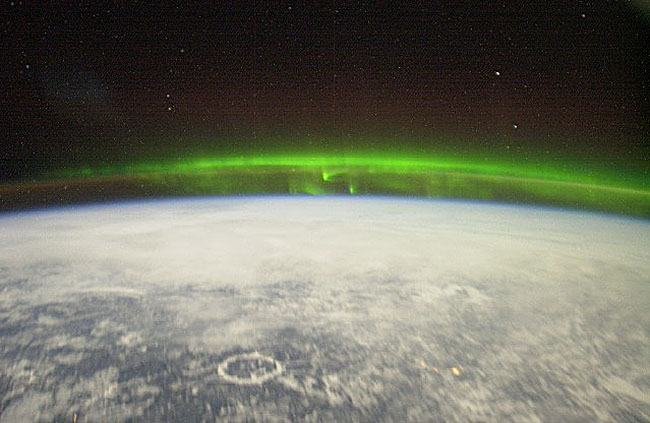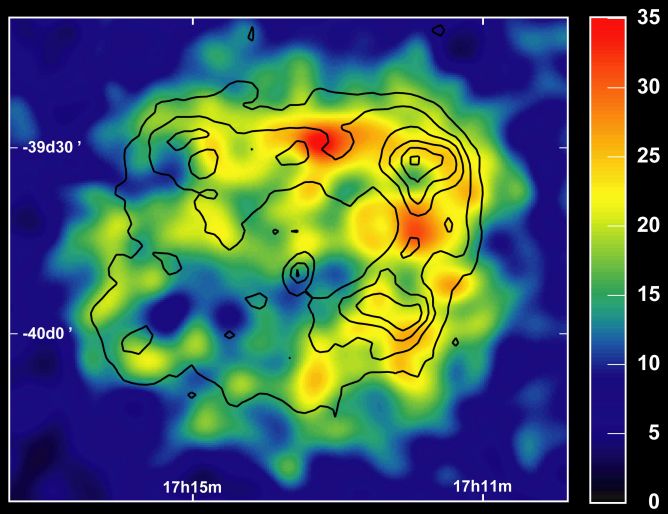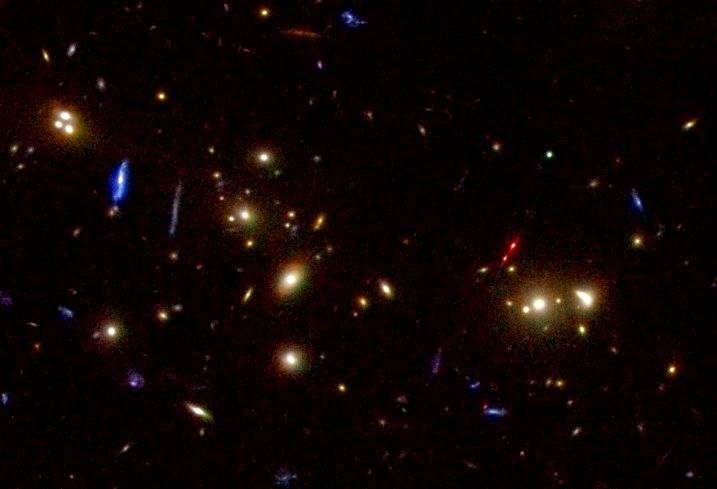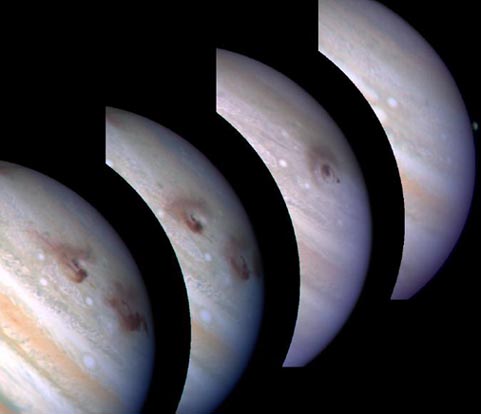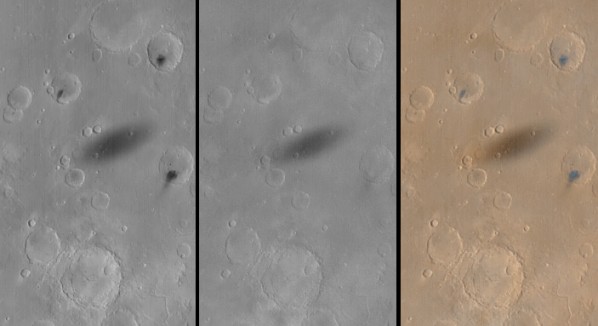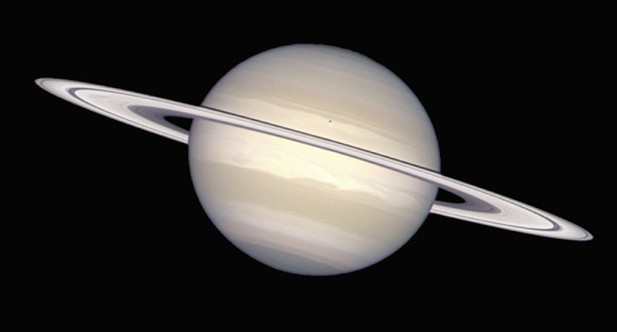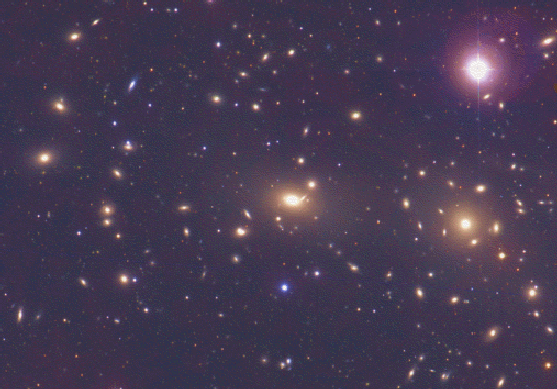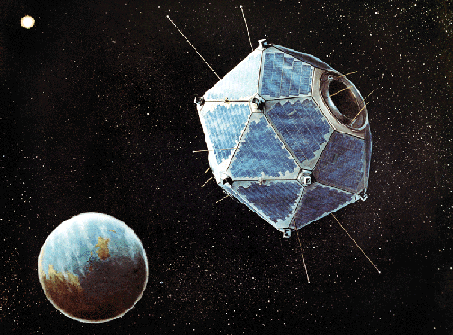| << Previous | Index | Next >> |
2014 Why is there a bright line on the sky? What is pictured above is actually a disk galaxy being seen almost perfectly edge on. The image from the Hubble Space Telescope is a spectacular visual reminder of just how thin disk galaxies can be. NGC 4762, a galaxy in the nearby Virgo Cluster of Galaxies, is so thin that it is actually difficult to determine what type of disk galaxy it is. Its lack of a visible dust lane indicates that it is a low-dust lenticular galaxy, although it is still possible that a view from on top would reveal spiral structure. The unusual stellar line spans about 100,000 light years from end to end. Near NGC 4762's center is a slight bulge of stars, while many background galaxies are visible far in the distance. Galaxies that appear this thin are rare mostly because our Earth must reside (nearly) in the extrapolated planes of their thin galactic disks. Galaxies that actually are this thin are relatively common -- for example our own Milky Way Galaxy is thought to be about this thin.
2013 Even though Kepler-78b is only slightly larger than the Earth, it should not exist. Its size is extraordinary only in the sense that it is the most similar in size to the Earth of any exoplanet yet directly discovered. Its orbit, however, is extraordinary in the sense that it circles a Sun-like star 40 times closer than planet Mercury. At such a scathing distance, even rock is liquid. Models of planet formation predict that no planet can form in such a close orbit, and models of planet evolution predict that Kepler-78b's orbit should decay -- dooming the planet to eventually merge with its parent star. Illustrated above in comparison with the Earth, Kepler-78b was discovered by eclipse with the Earth-trailing Kepler spacecraft and further monitored for subtle wobbles by the HARPS- North, a spectrograph attached to the 3.6-meter Telescopio Nazionale Galileo in the Canary Islands.
2012 Why does one half of Dione have more craters than the other? Start with the fact that Saturn's moon Dione has one side that always faces Saturn, and one side that always faces away. This is similar to Earth's Moon. This tidal locking means that one side of Dione always leads as the moon progresses in its orbit, while the other side always trails. Dione should therefore have undergone a significant number of impacts on its leading half. Strangely, the current leading half of Dione is less cratered than the trailing half. A leading explanation is that some crater-forming impacts were so large they spun Dione, changing the part that suffered the highest impact rate before the moon's spin again became locked. The above detailed image of Dione highlighting the moon's subtle hues is a meticulously-constructed mosaic -- by an dedicated amateur -- of pictures taken during the April 2010 flyby of Dione by NASA's robotic Cassini spacecraft.
2011 Early in the 20th century, GK Persei briefly became one of the brightest stars in planet Earth's sky, an event known as Nova Persei 1901. Documented in this modern day composite of two images from 2003 and 2011 the ejecta from the explosion, popularly called the Firework Nebula, continues to expand into space. These images are part of a time lapse video tracking the nebula's expansion over the last 17 years. About 1500 light-years away, the nebula is still just under a light-year in diameter. GK Per and similar cataclysmic variable stars known as classical novae are understood to be binary systems consisting of a compact white dwarf star and swollen cool giant star in a close orbit. The build up of mass transferred to the surface of the white dwarf from the giant star through an accretion disk eventually triggers a thermonuclear outburst, blasting the stellar material into space without destroying the white dwarf star. With a 2 day orbital period, the GK Per system has produced much smaller outbursts in recent years.
2010 Follow these 5 frames clockwise starting from the top left to track the view from the EPOXI mission spacecraft as it approached, passed under, and then looked back at the nucleus of comet Hartley 2 on November 4. Its closest approach distance was about 700 kilometers. In fact, this encounter was the fifth time a spacecraft from planet Earth has imaged a comet close-up. But Hartley 2's nucleus is definitely the smallest one so far, its long axis spanning only about 2 kilometers (1.2 miles). Though Hartley 2 is small, these stunning images showing jets of dust and gas indicate an impressively active surface. The jets are seen originating from the rough surface areas, with sunlight illuminating the nucleus from the right. Remarkably, rough areas at both ends of the elongated nucleus are joined by a narrower, smooth waist. The EPOXI mission reuses the Deep Impact spacecraft that launched a probe impacting the nucleus of comet Tempel 1 in 2005.
2009 Illuminating the landscape all through the night of November 2nd, this week's bright Full Moon was known in the northern hemisphere as a Hunter's Moon. But this dramatic view of the shining lunar orb, from Sobreda, Portugal, was captured just a few nights earlier, on Halloween. In the spirit of the season, the image plays a little trick. The picture is actually two digital photos - one short and one long exposure. They were combined to bring out the details of the bright lunar surface and the fainter features in the dark, surrounding clouds, in a single image. Of course, you may recognize some of the spookier shapes in the clouds as having visited your neighborhood last week, along with Halloween's Moon.
2008 Above is one of the closest pictures yet obtained of Saturn's ice-spewing moon Enceladus. The image was taken from about 1,700 kilometers up as the robotic Cassini spacecraft zoomed by the fractured ice ball last week. Features the size of a bus are resolvable in this highly detailed image taken of Enceladus' active tiger stripe region. Very different from most other moons and planets, grooves and hills dot an alien moonscape devoid of craters. Space pioneers might wonder where, on such a highly textured surface, a future probe might land in search of freshly deposited ice, subsurface seas, or even indicators of life. Although appearing dark in the above contrast-enhanced image, the surface of Enceladus is covered with some of the brightest ice in the entire Solar System, reflecting about 99 percent of the light it receives. To help better understand this enigmatic world, Cassini is scheduled to swoop by Enceladus at least five more times.
2007 Comet Holmes continues to be an impressive sight to the unaided eye. The comet has diminished in brightness only slightly, and now clearly appears to have a larger angular extent than stars and planets. Astrophotographers have also noted a distinctly green appearance to the comet's coma over the past week. Pictured above over Spain in three digitally combined exposures, Comet 17P/Holmes now clearly sports a tail. The blue ion tail is created by the solar wind impacting ions in the coma of Comet Holmes and pushing them away from the Sun. Comet Holmes underwent an unexpected and dramatic increase in brightness starting only two weeks ago. The detail visible in Comet Holmes' tail indicates that the explosion of dust and gas that created this dramatic brightness increase is in an ongoing and complex event. Comet Holmes will move only slightly on the sky over during the next month.
2006
2005 From the ground, spectacular auroras seem to dance high above. But the International Space Station (ISS) orbits at nearly the same height as many auroras, sometimes passing over them, and sometimes right through them. Still, the auroral electron and proton streams pose no direct danger to the ISS. In 2003, ISS Science Officer Don Pettit captured the green aurora, pictured above in a digitally sharpened image. From orbit, Pettit reported that changing auroras appeared to crawl around like giant green amoebas. Over 300 kilometers below, the Manicouagan Impact Crater can be seen in northern Canada, planet Earth.
2004 Gamma rays are the most energetic form of light. With up to a billion times the energy of ordinary "medical" x-rays, they easily penetrate telescope lenses and mirrors, making it very difficult to create gamma-ray images of cosmic sources. Still, an array of large telescopes designed to detect gamma-ray induced atmospheric flashes - the HESS (High Energy Stereoscopic System) experiment - has produced this historic, resolved image of a supernova remnant at extreme gamma-ray energies. Astronomers note that the premier gamma-ray view of the expanding stellar debris cloud is clearly similar to x-ray images of the remnant and convincingly supports the idea that these sites of powerful shock waves are also sources of cosmic rays within our galaxy. The gamma-ray intensity is color-coded in the picture, shown with dark contour lines that trace levels of x-ray emission from the object. At an estimated distance of 3,000 light-years, the supernova remnant measures about 50 light-years across and lies near the galactic plane.
2003 While chasing the spectrum of a mysterious arc in a cluster of galaxies within the obscure northerly constellation Lynx, astronomers have stumbled upon the most massive and distant star-forming region ever discovered. The notably red "Lynx arc" lies right of center in this color image of the galaxy cluster, a composite of Hubble Space Telescope and ground-based data. While the galaxy cluster lies about 5 billion light-years distant, spectroscopic studies show that the arc itself is actually a distorted image of an even more distant but enormous star-forming region. The image is formed as the closer galaxy cluster's gravity bends light like a magnifying lens, an effect explained by Einstein's theory of gravity. In fact, the monster star-forming region is nearly 12 billion light-years away and about a million times brighter than the more familiar stellar nursery, the Orion Nebula. Estimates are that the star-forming region seen as the Lynx arc contains about a million massive, hot stars, compared to the four stars which power the Orion Nebula's glow. Stars within the Lynx arc are more than twice as hot as the Orion Nebula's central stars and were formed when the Universe was a mere 2 billion years old. Still, astronomers believe that the first stars were formed at even earlier times.
2002 This year's Leonid Meteor Shower is predicted to have two peaks, like last year's. The first peak should come at about 04:00 hours Universal Time (UT) on November 19 and be primarily visible from Western Europe before sunrise. The second peak is predicted to occur at about 10:30 UT and be primarily visible from North America before local sunrise. During these times, the Leonid Meteor Shower might well develop into a true meteor storm, with rates possibly exceeding those measured during last year's storm. The meteors in these two peaks come from sand-sized particles ejected from Comet Tempel-Tuttle during trips to the inner Solar System in 1767 and 1866, respectively. If you're stuck without a view you can still catch the shower by looking for streaks caught by the web cameras of the Night Sky Live Project. Pictured above are several meteors from the 2001 Leonids streaking over Joshua Tree National Park in California, USA.
2001 What's happening above that city? The city is Winnipeg, Canada, and the phenomenon is aurora. These past few months have been active ones for our Sun, producing several coronal mass ejections (CMEs) of particles that have swept past our Earth and caused many spectacular auroras. Specifically in this case, a CME that occurred on October 9 impacted the Earth on October 11 and 12, causing nearly 12 hours of auroras. The above-pictured aurora had to be very bright to be seen over the lights of Winnipeg, the city well below and in front of the cascading atmospheric airglow. Lights reflecting off of a slight haze cause an unrelated glow that emanates from some of the buildings.
2000 What happens when a comet encounters a planet? If the planet has a rocky surface, a huge impact feature will form. A giant planet like Jupiter, however, is mostly gas. When Comet Shoemaker-Levy 9 struck Jupiter in 1994, each piece was swallowed into the vast Jovian atmosphere. Pictured above is a time-lapse sequence of the result of two fragments striking Jupiter. As the comet plunged in, it created large dark marks that gradually faded. The high temperature of gas under Jupiter's cloud tops surely caused the comet fragment to melt before it plunged very far. Because Jupiter is much more massive than any comet, the orbit of Jupiter around the Sun did not change noticeably.
1999 Hurtling through space above the Red Planet, potato-shaped Phobos completes an orbit of Mars in less than eight hours. In fact, since its orbital period is shorter than the planet's rotation period, Mars-based observers see Phobos rise in the west and set in the east - traveling from horizon to horizon in about 5 1/2 hours. These three images from the Mars Global Surveyor (MGS) spacecraft record the oval shadow of Phobos racing over western Xanthe Terra on August 26, 1999. The area imaged is about 250 kilometers across and is seen in panels from left to right as red filter, blue filter, and combined color composite views from the MGS wide-angle camera system. The three dark spots most easily seen in the red image are likely small fields of dark sand dunes on crater floors. Standing in the shadow of Phobos, you would see the Martian version of a solar eclipse!
1998 What you could see approaching Saturn aboard an interplanetary cruise ship would closely resemble this subtly shaded view of the gorgeous ringed gas giant. Processed by the Hubble Heritage project, the picture intentionally avoids overemphasizing color contrasts and presents a natural looking Saturn with cloud bands, storms, nearly edge-on rings, and the small round shadow of the moon Enceladus near the center of the planet's disk. Of course, seats were not available on the only ship currently enroute - the Cassini spacecraft, launched just over a year ago and scheduled to arrive at Saturn in the year 2004. After an extended cruise to a world 1,400 million kilometers from the Sun, Cassini will tour the Saturnian system, conducting a remote, robotic exploration with software and instruments designed by denizens of planet Earth.
1997 Our Milky Way galaxy appears to be surrounded by a halo of gamma rays. Gamma rays are the most energetic form of electromagnetic radiation, with more than a hundred thousand times the energy of visible light, but known gamma-ray sources don't account for the diffuse distribution of this high-energy glow. This surprising result is based on data from the EGRET instrument onboard the Compton Gamma Ray Observatory. In this false color all-sky image centered on the Milky Way, the brown and green regions indicate brighter, known sources of gamma-rays. The galactic center and plane clearly standout as do some distant galaxies seen near the top and bottom of the picture. The dim, blue regions above and below the plane correspond to our Galaxy's unexpected gamma-ray halo. What causes the halo? Future gamma-ray telescopes could solve this mystery. However, the excitement has already inspired tantalizing speculation about the solution including; collisions of low energy photons with high-energy cosmic rays, high energy electrons accelerated by a previous burst of Milky Way star formation, and exotic interacting particles which make up Dark Matter.
1996 Almost every object in the above photograph is a galaxy. The Coma Cluster of Galaxies pictured is one of the densest clusters known - it contains thousands of galaxies. Each of these galaxies house billions of stars - just like our own Milky Way Galaxy. Although nearby when compared to most other clusters, light from the Coma Cluster still takes hundreds of millions of years to reach us. In fact, the Coma Cluster is so big it takes light millions of years just to go from one side to the other! Most galaxies in Coma and other clusters are ellipticals, while most galaxies outside of clusters are spirals. The nature of Coma's X-ray emission is still being investigated.
1995 In October of 1963 the US Air Force launched the first in a series of satellites inspired by a recently signed nuclear test ban treaty. Signatories of this treaty agreed not to test nuclear devices in the atmosphere or in space. These "Vela" (from the Spanish verb velar, to watch) satellites were part of an unclassified program whose goal was to develop the technology to monitor nuclear tests from space. A Vela satellite is pictured above in an artist's conception, keeping watch over the Earth. The high energy radiation sensors onboard the Velas did not detect any clandestine nuclear explosions. Instead, in the most surprising discovery in the history of space based astronomy, they found bursts of gamma rays coming from deep space! The mysterious origin of these brief, intense flashes of gamma rays is one of the most hotly debated topics in modern astrophysics.
| << Previous | Index | Next >> |
